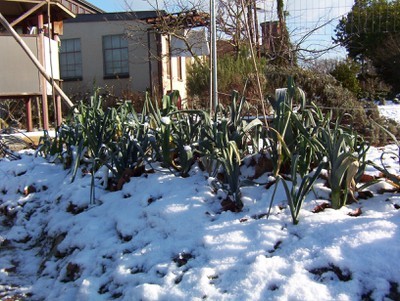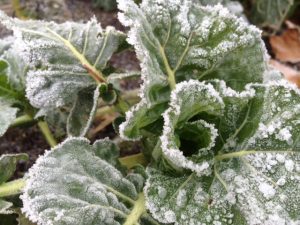
How well your plants will fare during bouts of winter snow and freezing temperatures depends on many factors. You will want to look at how well your plants are sheltered, the hardiness of your varieties and the maturity of your plants. If plants are already under stress or if they are in containers, they might sustain considerable damage and sometimes these effects will not be seen for months or even years. Here are a few guidelines to help you minimize winter plant damage.
Mulch!
One of the best preventive measures to protect plants from winter damage is to do a fall application of mulch to your beds. Adding a few inches of a good organic material to the soil surface will help to insulate the roots of your plants and conserve water by keeping your plants hydrated. Leaves that have fallen on site and free wood chips from arborists are a great resource for not only protecting your plants but for building healthy soil at the same time. Just be sure to leave a mulch free collar around woody plant trunks to prevent disease. Learn more about mulching techniques from our Garden Hotline video tip.
Leave the Snow!
If snow or ice accumulates on your plants, let it melt off on its own. Removing snow can cause branches to snap back abruptly and damage the circulatory system of the plant. Snow actually has an insulating effect on plants when we encounter frigid nighttime temperatures. Vertical branching conifers (like Japanese holly or the oh-so-common screening plant, arborvitae) are an exception to this advice, as they will bend with the weight of our heavy snows but not bounce back once the snow is gone. In this situation it is important to knock heavy snows off to allow the branches to revert to their normal position.
Treat Fallen Trees
If a small to medium sized tree becomes uprooted in a wind or snow storm, sometimes it can be saved if at least one third of the root system is still in the ground. Wait to put it back in the ground until soil temperatures have warmed up. In the meanwhile, prune broken branches to avoid further tearing, but wait until spring for most pruning so that you can determine if branches are indeed dead before making the cut. Pruning out live wood, especially in early spring, can further stress the tree.
Watch Where You Salt
Salt damage can cause twig dieback and early fall coloration. Buds and small twigs of some plant species become more prone to freezing and may be slow or fail to open in the spring when this damage occurs. Salts can also absorb water making it unavailable to roots and thus dehydrating the plant. Be judicious when applying salt to pathways to avoid damaging your plants. Try alternatives like sand for traction.
Assess Winter Damage
If the buds of spring bloomers have been damaged—having turned brown or black—you will get fewer flowers this year. Leaves of broadleaf evergreens often droop during cold weather, but will uncurl when it warms up. Brown leaves can be due to sun and/or wind damage; wait until mid-spring before pruning out injured foliage
Wrap Up Your Roots
Some plants, especially those in containers, may sustain root damage (roots look blackish and are often soft) because they are not as protected as plants planted directly into the soil. They might leaf out in the spring but will then wither and die as they push out new growth. Protect potted plants by making sure the soil is well watered and the plant hydrated. Move more tender varieties to sheltered areas, being aware of the possible need to water if you are sheltering on a porch or near the house. Smaller pots can be heeled into a mulch pile in the yard for insulation or wrapped with insulating materials like burlap or bubble wrap to protect the root system.
Watch the Sun
Sun scald is another problem, especially for trees that have been newly planted or those with smooth or thin bark. Wrap the trunk with a light-colored covering like floating row cover, keeping it on through the winter and into the first growing season. If a fruit tree has been damaged, remove developing fruits to prevent further stress on the tree. Monitor for signs and symptoms of insect damage.
Stay off the Lawn
Frozen lawns are susceptible to damage if there is a lot of foot traffic on them. Avoid walking across the lawn during frigid weather if possible. Don’t plan renovation work until early spring to avoid periods of cold weather when the lawn will be under stress.
Keep them Wet
If you sustain winter damage on your plants make sure that they then receive adequate water through spring, summer and fall. Mulch liberally and fertilize as needed, avoiding excess soluble nitrogen fertilizer. Slightly decrease water in September to encourage hardening off, but water thoroughly in October until we get a freeze. It is important for plants to be adequately hydrated when entering cold temperature extremes.
Be Ready to Replace
If a tree loses more than half of its branches, it may not be worth saving. If bark has been ripped, woody plants are at risk of sunscald or decay. If you need to replace a damaged tree, consider replacements that will withstand the effects of severe winter weather. Conically shaped trees and those with more horizontal branching sustain the least amount of damage. Slow growing trees (their wood is not as brittle) and those with wide branch crotches also fare better.
Plan for Prevention
For future garden planning take care to site your new plants well. Tall trees should be planted far from utility lines. Site broadleaf evergreens that easily succumb to winter damage in areas where they are protected from both winter wind and sun. These include daphne, camellia, azalea and rhododendron. Do not let them dry out, especially as fall wanes and we enter winter cold spells, by protecting the roots of immature shrubs with extra mulch or burlap. Avoid planting in areas that maintain winter wet or that will be in the path of falling snow or ice. Also, stay away from planting under the eaves of houses unless you plan to water through the winter.
